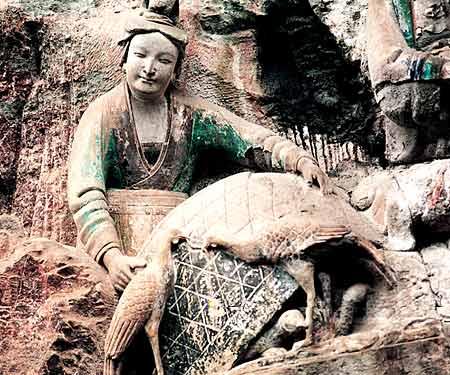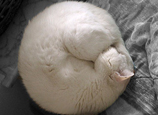
 |
| Reflecting real life is a notable feature of the Dazu Rock Carvings. The picture shows the chicken-raising girl in the "Entering Hell" statue. (CNTV) |
The Dazu Rock Carvings are located in Dazu County, Chongqing Municipality. The carving work began in the Yonghui period of the early Tang Dynasty (649 A.D.) and continued until the Ming and Qing dynasties (between the 14th century and the 19th century). Through the late Tang Dynasty and the Five Dynasties period (between 907 A.D. and 959 A.D.) the work entered its prime and distinguished itself during the Northern and Southern Song Dynasties (between 960 A.D. and 1278 A.D.). The rock carvings are mainly Buddhist statues, together with Confucian and Taoist statues. The Dazu Rock Carvings represent the later period of Chinese grotto art and have epitomized the essence of the rock carving art in China. The Dazu Rock Carvings enjoy the same fame as the Yungang, Longmen and Dunhuang Grottoes, and bear significant historical, artistic, religious and scientific values.
The Dazu Rock Carvings are made up of 1,030 niche grottoes and over 60,000 statues scattered in more than 100 locations including 77 cultural relic protection sites at various levels. Beishan, Baodingshan, Nanshan, Shizhuanshan and Shimenshan boast the largest number of and the most famous carvings. The Dazu Rock Carvings were built while emphasizing the differences between rock carving and clay sculpture just like in the north part of China at that time, and rock sculpture techniques were also used to make the carvings look splendid and delicate. The carvings in Dazu have very rich subjects and do not only consist of Buddhist, Taoist and Confucian statues, but also sculptures of historical figures. Buddhist statues account for over 60 percent of the total carvings, the largest proportion. The largest concentration and scale of Buddhist carvings are at Baodingshan and Beishan, while most Taoist carvings are found in Nanshan and the Banbian Temple.


















 Wild Siberian tiger kills cattle in NE China
Wild Siberian tiger kills cattle in NE China


![]()
